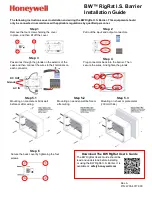
34
WARNING
This detector is designed for use in Zone 1 and Zone 2
hazardous areas, and is certified
II 2 G EExd IIC T3.
Installation must be in accordance with the recognised
standards of the appropriate authority in the country
concerned.
For further information please contact Crowcon. Prior to
carrying out any installation work ensure local regulations and
site procedures are followed.
2.1 Location
The detector should be mounted where the gas to be detected is most
likely to be present. The following points should be noted when locating
gas detectors:
•
To detect gases which are lighter than air, detectors should be
mounted at high level.
•
To detect heavier than air gases, detectors should be mounted at low
level.
•
When locating detectors consider the possible damage caused by
natural events e.g. rain or flooding.
•
Consider ease of access for functional testing and servicing.
•
Consider how the escaping gas may behave due to natural or forced
air currents. Mount detectors in ventilation ducts if appropriate.
•
Consider the process conditions. For example, butane is normally
heavier than air, but if released from a process which is at an elevated
temperature and/or pressure, the gas may rise rather than fall.
The placement of sensors should be determined following advice of
experts having specialist knowledge of gas dispersion, the plant
processing equipment as well as safety and engineering issues.
The
agreement reached on the locations of sensors should be recorded.
Crowcon would be pleased to assist in the selection and siting of gas
detectors.
2. Installation
Xgard Type 4
















































